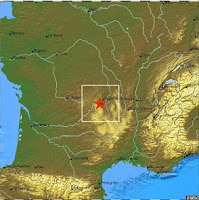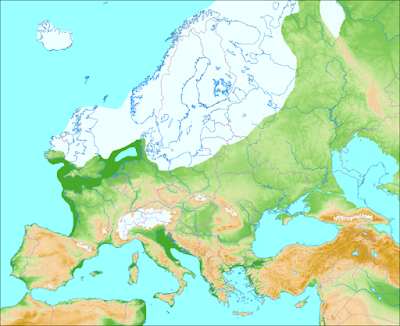The Centre Sismologique Euro-Méditerranéen
recorded a Magnitude 3.0 Earthquake at a depth of 2 km in
the Ille-et-Vilaine Department of the Brittany region of northwest France, at about
9.30 am local time (about 8.30 am GMT) on Thursday 17 December 2015.
There are no reports of any damage or injuries associated with this event (and nor would they be expected with a quake this size), but people have reported feeling it locally.
The approximate location of the 17 December 2015 Ille-et-Vilaine Earthquake. Google Maps.
The precise cause of Earthquakes in France can be hard to determine; the
country is not close to any obvious single cause of such activity such
as a plate margin, but is subject to tectonic pressures from several
different sources, with most quakes probably being the result of the
interplay between these forces.
France is being pushed to the east by the expansion of the Atlantic
Ocean and to the north by the impact of Africa into Europe from the
south. It is also affected by lesser areas of tectonic spreading beneath
the North Sea, Rhine Valley and Bay of Biscay. Finally the country is
subject to glacial rebound; until about 10 000 years ago much of the
mountainous and upland areas of the country were covered by a thick
layer of glacial ice, pushing the rocks of the French lithosphere down
into the underlying mantle. This ice is now gone, and the rocks are
springing (slowly) back into their original position, causing the
occasional Earthquake in the process.
Glacial rebound seems an unlikely cause of Earthquakes in the Channel
region, an area that was never glaciated, but this is not entirely the
case. The northwest of Scotland is rising up faster than any other part
of the UK, but the Earth's crust on land in the UK is fairly thick, and
does not bend particularly freely, whereas the crust beneath the Channel
is comparatively thin and more inclined to bend under stress. Thus
uplift in Scotland can cause the entire landmass of Great Britain to
pivot, causing movement in the rocks beneath the Channel, and affecting
both the English and French coasts.
(Top) Simplified diagram showing principle of glacial rebound.
(Bottom) The extent of glaciation in Europe at the last glacial maximum.
Wikipedia.
Witness
accounts of Earthquakes can help geologists to understand these events,
and the structures that cause them. The international non-profit
organization Earthquake Report is interested in hearing from people who may have felt this event; if you felt this quake then you can report it to Earthquake Report here.
See also...
 Magnitude 4.9 Earthquake in southern France. The Centre Sismologique Euro-Méditerranéen recorded a Magnitude 4.9 Earthquake at a depth of 5 km in
the Hautes-Alpes Department of southeastern...
Magnitude 4.9 Earthquake in southern France. The Centre Sismologique Euro-Méditerranéen recorded a Magnitude 4.9 Earthquake at a depth of 5 km in
the Hautes-Alpes Department of southeastern...  Magnitude 2.9 Earthquake in northern France. A Magnitude 2.9 Earthquake at a depth of 10 km occurred beneath the
commune of Miniac-Morvan, near St Malo in Brittany, northern France,
slightly after 11.35 pm local time (slightly after 9.35 pm, GMT) on
Wednesday 3 July 2013, according to the Laboratoire de Détection et de Géophysique.
There are no...
Magnitude 2.9 Earthquake in northern France. A Magnitude 2.9 Earthquake at a depth of 10 km occurred beneath the
commune of Miniac-Morvan, near St Malo in Brittany, northern France,
slightly after 11.35 pm local time (slightly after 9.35 pm, GMT) on
Wednesday 3 July 2013, according to the Laboratoire de Détection et de Géophysique.
There are no... Earthquake in the Auvergne Region, France, On Thursday 12 July 2012, at 3.22 am local time (1.22 am GMT) an
Earthquake occurred in the Auvergne Region of France, roughly 19 k
southwest of Clermont-Ferrand, according to the Centre Sismologique Euro-Méditerranéen,
who reported the quake as measuring 3.0 on the Richter Scale and
occurring at a depth of 2 km. A quake of this size is highly unlikely to
have caused any damage or casualties, but may...
Earthquake in the Auvergne Region, France, On Thursday 12 July 2012, at 3.22 am local time (1.22 am GMT) an
Earthquake occurred in the Auvergne Region of France, roughly 19 k
southwest of Clermont-Ferrand, according to the Centre Sismologique Euro-Méditerranéen,
who reported the quake as measuring 3.0 on the Richter Scale and
occurring at a depth of 2 km. A quake of this size is highly unlikely to
have caused any damage or casualties, but may...
Follow Sciency Thoughts on Facebook.



